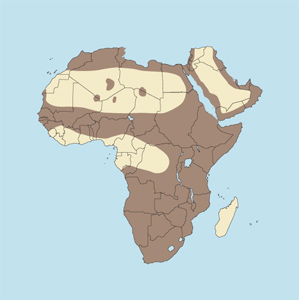 |
Felis silvestris lybica
Gato montés, gato silvestre (Sp), Falbkatze (G), Chat ganté, chat sauvage d'Afrique (F), Vaalboskat (Af), Paka mwitu (Swahili).
DESCRIPTION (male) Head and body length 21-26 inches (545-665 mm). Tail 11-14 inches (275-360 mm). Weight 9-14 pounds (4-6 kg). (female) Head & body length 18-24 inches (460-620 mm). Tail 10-14 inches (255-355 mm). Weight 5-11 pounds (2.3-5.0 kg).
Females have four pairs of teats.
The African wildcat is generally recognized as the ancestor of the domestic cat (Felis catus) and often interbreeds with it. The two species are similar in size and appearance and can be difficult to identify in the field; however, there are two features that distinguish purebred wildcats from domestic cats and hybrids. In the wildcat, the backs of the ears are a rich reddish-brown, while domestic cats and hybrids usually have dark gray or black-backed ears, with perhaps a little red. A second feature is the wildcat's long legs. When a wildcat sits upright, its long front legs raise the body almost to the vertical, a position that is nearly impossible for domestic cats or hybrids. The coat is short with highly variable coloration, ranging from reddish to sandy yellow to tawny or gray. It is usually marked with faint "tabby" stripes and spots.
BEHAVIOR Mainly nocturnal, but also active during twilight. Climbs trees with great agility and seems to enjoy sunning on a branch. Feeds mainly on rodents, although birds, reptiles, amphibians and young antelope are also taken, as well as insects and arachnids when other prey is scarce. Will sometimes eat fruit. Seldom eats carrion. Wildcats are solitary and highly territorial. In southern and eastern Africa, litters of 2-5 kittens (averaging three) are born during the wet season from September to March, mainly in holes in the ground that have been excavated by other species, but also in rock crevices, or in underbrush, tall grass, haystacks and agricultural fields. In the northern Sahara, breeding takes place from January to March. Estrus lasts 2-8 days and females may come into heat several times a year. Kittens are blind at birth, but their eyes open in 9-11 days. They nurse for about 30 days, are mobile at one month, independent at five months, and sexually mature at one year. Captives have lived to be 15 years old.
HABITAT African wildcats are very tolerant of habitat. Absent only from tropical rain forest and the dryest deserts. They occur thinly in the Sahara, Nubian and Arabian deserts, although restricted to mountains and watercourses. Found at altitudes ranging from sea level to 3,000 meters.
DISTRIBUTION Throughout Africa except for rain forest and true desert. The African wildcat is also found in the Sinai peninsula, Jordan, Israel, Syria, Iraq and the rest of the Arabian peninsula, which are in Asia.
TAXONOMIC NOTES Smithers lists 11 subspecies of wildcats in Africa: lybica (northern Africa), caffra (southern Africa), brockmani (Horn of Africa), ocreata (Ethiopia), griselda (southwestern Africa) and also foxi, haussa, mellandi, rubida, sarda and ugandae. All are combined here, with lybica Forster, 1780 having priority.
STATUS The main threat to the African wildcat is hybridization with domestic cats. Some scientists believe that male feral cats have an advantage over male wildcats in access to estrous females, because of their larger size and greater numbers. Smithers (1986) believed it inevitable that hybridization would "lead to the virtual extinction of the African wildcat as we know it at present." Listed on Appendix II of CITES, as with most cats.
|





